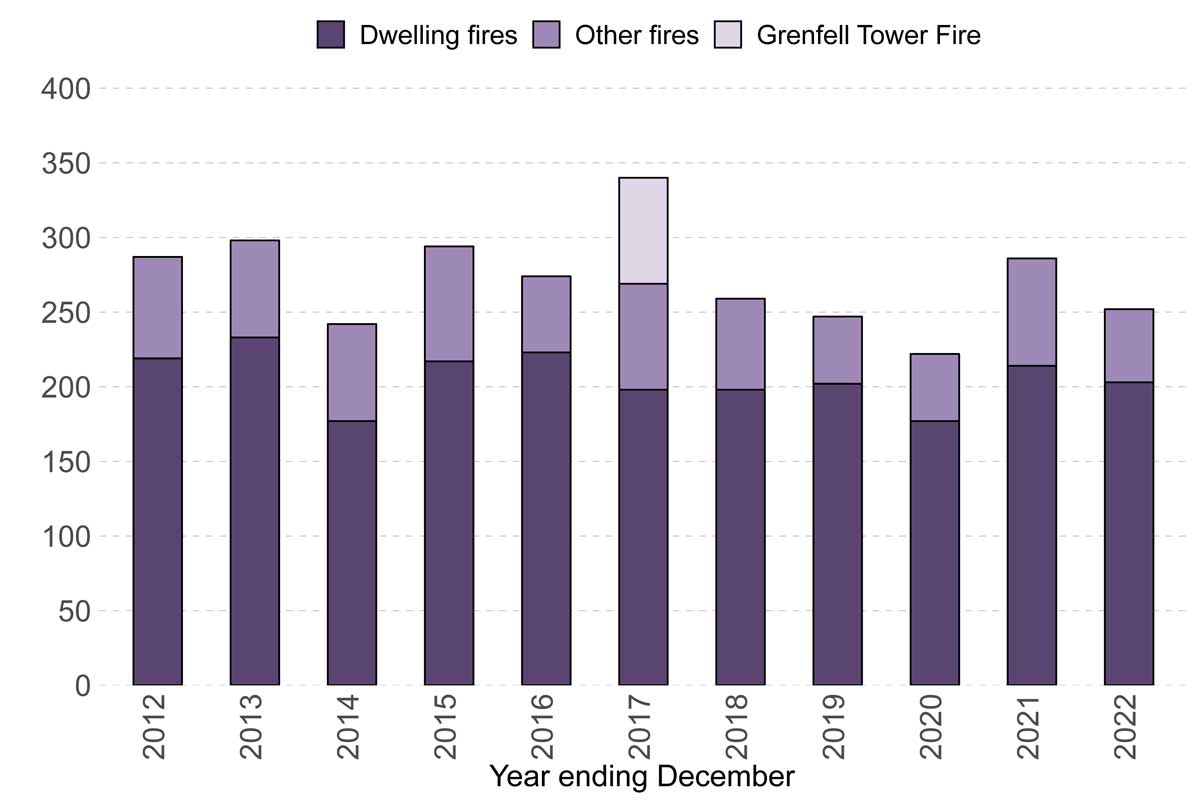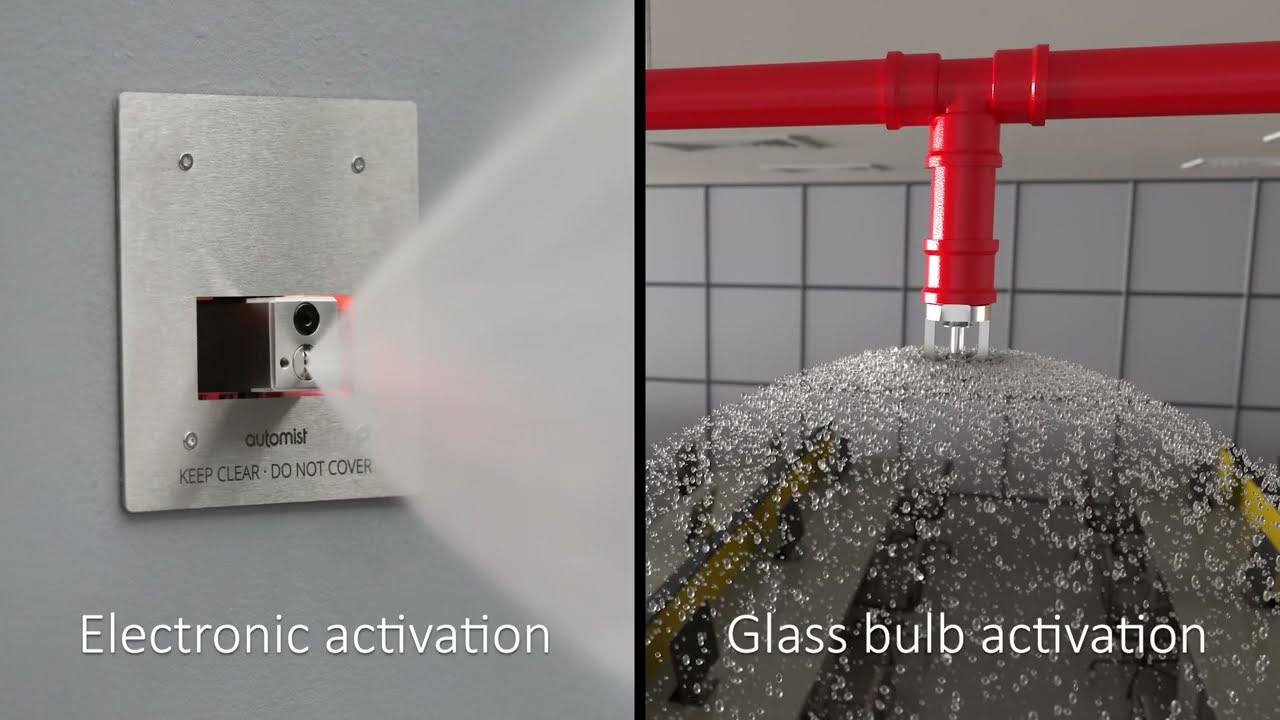How can we lower the number of UK fire-related fatalities and injuries?
With an ageing population and overcrowding forecast, reducing fire-related deaths and injuries will be challenging
- Most fire-related fatalities are in dwellings (76%). Fire fatalities and injuries disproportionately affect older people. There were 4.8 fire-related fatalities for every million people in England, and the fatality rate was highest among older people: 10.4 people per million for those aged 65 to 79 years old and 19.7 for those aged 80 years and over1.
- The greatest risk of death is for those in the room in which the fire starts; often those in the room are directly involved in the fire (e.g. their clothing or bedding is the item first ignited)2.
- Fire fatality and serious injury victims are more likely to9:
- be falling asleep or asleep, or to have an underlying medical condition or illnesses
- have impairment due to drugs or alcohol, and both are more
- be chair-ridden or bedridden
- be in dwellings of single occupancy
- Around 1.1 per cent of the English population live in sheltered and extra care housing. Yet, during 2010-2016, nearly 5 per cent of all fire deaths in dwellings occurred in this type of housing; this disproportionate number of fatalities again underlines the vulnerability of the residents2.
- Data from across the UK suggests that fire deaths have plateaued but with a small increase in recent years. We should expect this number to rise because the UK population is ageing. There are over 11 million people aged 65, and in ten years, this will have increased to 13 million people, 22% of the population3.

Traditional fire sprinklers are more cost-effective in new build than retrofit
- Most fire regulations improvements relating to active fire suppression in recent years focus on new builds where implementation is the most cost-effective. For example, mandatory fire sprinklers in buildings over 11m and new care homes.
- We have a lot more fires in low to medium-rise buildings than in taller buildings. Of 7,335 fires in blocks of flats attended by fire services in 2021 and 2022, 4,645 were in low-rise buildings (one to three storeys), 1,907 were in medium-rise buildings (four to nine storeys) and 783 were in high-rise contexts (10 or more storeys). High-rise fires account for only 2% of fatal and severe casualties, according to a recent Home Office review of fire-related fatalities and severe casualties in England, spanning 2010-2019.
- There are approximately 24.9 million dwellings in England as of March 2021. This number increases year on year between 0.80% - 0.99%4. Therefore although the legislation improves the situation for future generations, it will have no impact on the existing housing stock.
- Fire sprinklers are typically most cost-effective in new builds where the water supply upgrade to support the system or space for the tank can be considered in the design. The variation in water supply cost contributes a large fraction of the uncertainty in the total system costs5.
- A risk-based approach to targeting retrofitting efforts makes sense to ensure available funds are most effectively used. A more targeted approach to a limited number of high-risk buildings will have a larger impact than blanket solutions on new ones7.
- 'Age of dwelling showed a strong correlation with fire risk. Just under half (47%) of dwellings with a higher risk of fire were built before 1919, highlighting that age and design are important factors. The proportion of homes built between 1919 and 1964 with a higher risk of fire was similar to the proportion of homes of this age in the whole stock. However, homes built after 1964, were relatively less likely to contain a higher fire risk'14.
A targeted retrofit programme guided by person-centred fire risk assessments (PCFRAs)
- To reduce fire risk for vulnerable individuals, person-centred fire risk assessments (PCFRAs) can be used to identify those at higher risk and gain an understanding of their risk profile so that appropriate measures can be put in place. Used in conjunction with an assessment and measures based on the type and structure of a building, PCFRAs can help to save lives as they consider the needs of the individual and recognise that one person may need something completely different from another8.
- An ageing population with increased vulnerabilities from conditions such as dementia will need protecting in ways that are increasingly more sophisticated than those used to date for able-bodied people capable of responding to alarms – and acting appropriately to save their own lives. The expectation that a fire alarm system will activate, and the FRS be informed and arrive to tackle the fire in time to save lives, is unrealistic for elderly and vulnerable people9.
- In a recent judicial review application (unsuccessfully challenging the decision by Birmingham CC to budget for retrofitting sprinklers), one of the concerns raised by the claimant was 'the disruption to tenants that would be caused during the fitting works and the unsightliness of surface-mounted retrofitted sprinklers and pipes'6.
Traditional fire sprinklers and personal protection systems (PPS) do not activate early enough
- Fire sprinklers provide particular benefit for low frequency, high consequence, incidents where there is unexpected early fire spread and delays in evacuation. The addition of sprinklers provides another layer of protection to control fire and help avoid multi-fatality incidents arising from early fire spread. However, fire sprinklers do not operate quickly enough to prevent death or serious injury of the person directly affected, typically in the room of origin11.
- Between 2010 and 2020, there were nine fatalities in dwellings protected by fire sprinklers, and in all but one of these cases, the victim was over the age of 65 years old12.
- A study of fatal dwelling fires, where sprinklers were present, found that the circumstances of the fire fell outside the life-saving operating parameters of the system's design. Typically, they were also unable to move away from the fire or remove clothing due to mobility issues. Often, they were medically more likely to succumb to burns or smoke inhalation due to age or infirmity13.
- When Dorset Fire and Rescue reviewed nine fatal fires within this elderly and infirm group in 2017, it found that on eight occasions, either the person's clothing or bedding was the item that ignited first. Not one was able to call the fire service themselves. Trials of several units demonstrated that PPS linked to smoke detection did not operate early enough to prevent anticipated fatal injuries due to rapid growth of flame around the front of the individual. Although the smoke detector was positioned in a favourable position, due to a clean burn from the clothing involved, the detection did not operate for up to 60 seconds.
New solutions need to be considered - electronically controlled fire suppression
- A new category of fire suppression system is being spearheaded by a UK company called Plumis. The newest edition of NFPA 750 (US water mist systems) has been published and includes the use of electronically controlled nozzles in its definitions.
- These systems are designed with retrofit in mind and are often more cost-effective to retrofit on a flat-by-flat basis than traditional fire sprinklers. They can be installed with reduced plumbing requirements, no tank or commercial water supply required, and less disruption because they use flexible hosing and do not have to be fitted in the ceiling.
- Fire engineering research shows Automist Smartscan can operate 2 to 14 times quicker than a concealed sprinkler. This is crucial, as every second counts, particularly in the room of fire origin for vulnerable people. The quicker a suppression system can respond and stop fire growth, the sooner it can lessen its heat and toxic product output. As a result, the conditions an individual is subject to are likely to be less severe for a fire which is suppressed sooner rather than later15.
Read more - Is there any fire engineering research that supports the use of Automist?
References:
- Detailed analysis of fires attended by fire and rescue services
- NFCC - Fire Safety in Specialised Housing
- https://ageing-better.org.uk/ageing-population
- Dwelling Stock Estimates
- Effectiveness of sprinklers in residential premises
- https://blogs.law.ox.ac.uk/housing-after-grenfell/blog/2019/07/retrofitting-sprinklers-mixed-tenure-blocks
- Never again, sprinklers as the next step towards safer homes by the London Assembly
- Fire Safety…It’s Not Just About the Building
- The causes of fire fatalities and serious fire injuries in Scotland and potential solutions to reduce them
- Open Consultation - Sprinklers in care homes
- Sprinkler Effectiveness in Care Homes
- Home Office Fire Data
- Incidence of Deaths and Injuries in Sprinklered Buildings by NFSN and NFCC
- English Housing Survey Fire and fire safety report, 2012-13
- Replicating the activation time of electronically controlled watermist system nozzles in B-RISK



